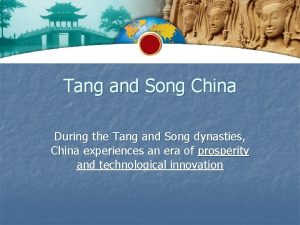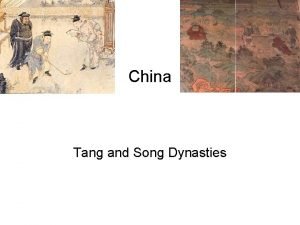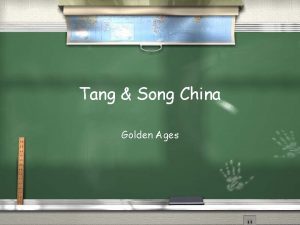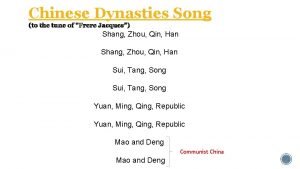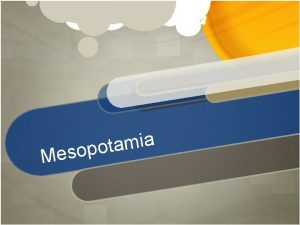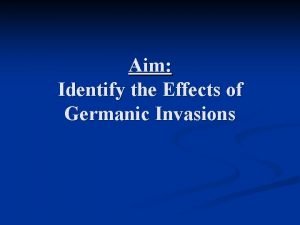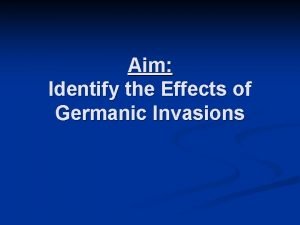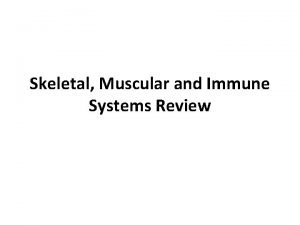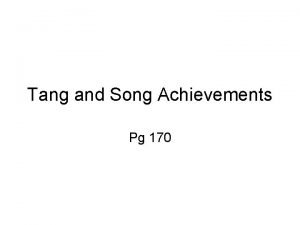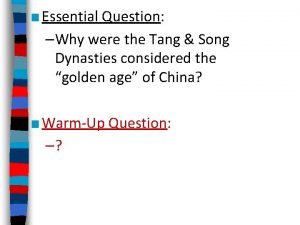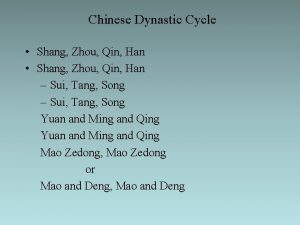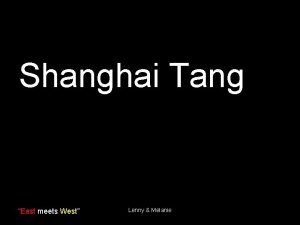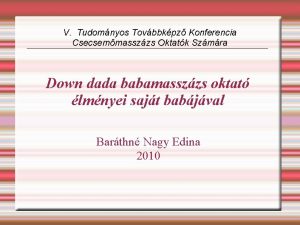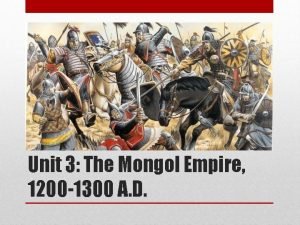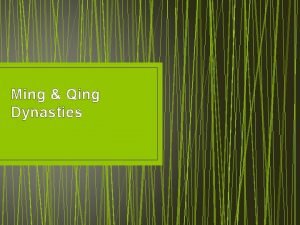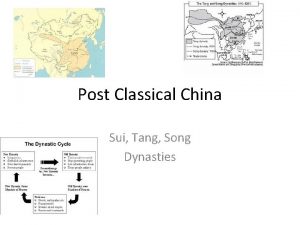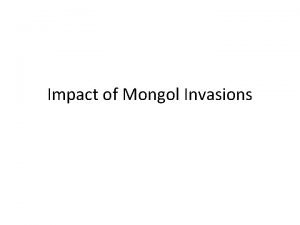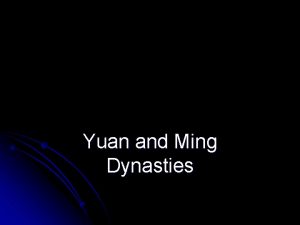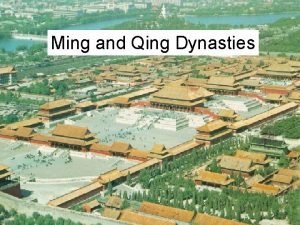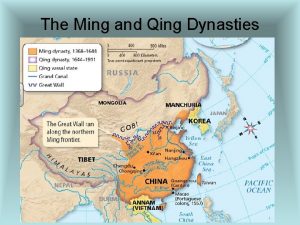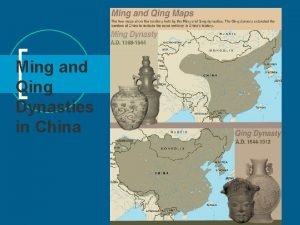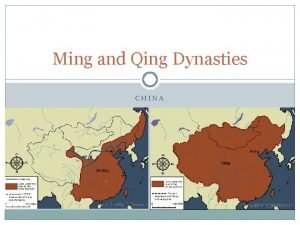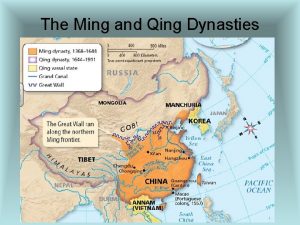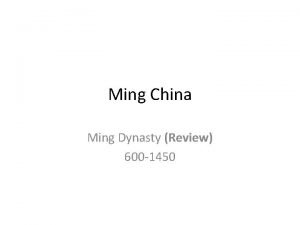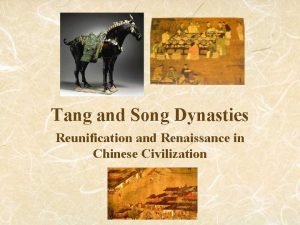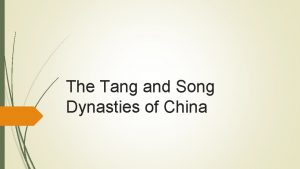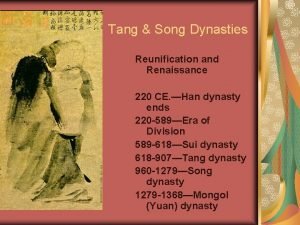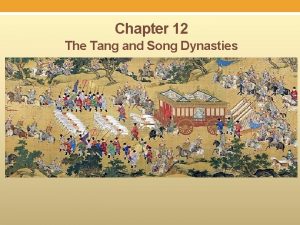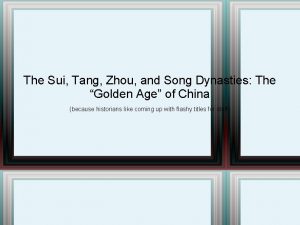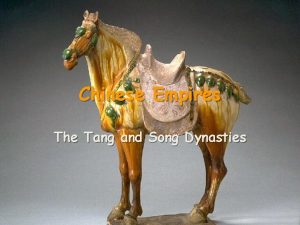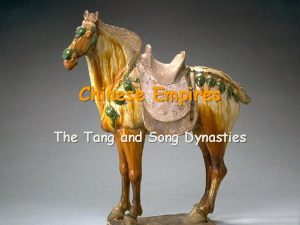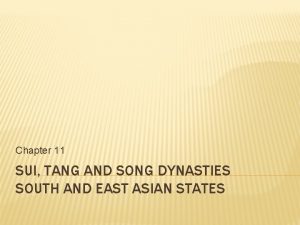Tang and Song Dynasties Mongol Invasions and Ming
























- Slides: 24

Tang and Song Dynasties, Mongol Invasions, and Ming Dynasty

Achievements – Pre- Tang Dynasty • Built the Grand Canal, which connected the Yellow River in the north and the Yangzi River in the south • Farmers and merchants in the south (rice) used the canal to connect to the North • Government and military officials could travel and control citizens • Many died while building the canal

Pre-Tang Dynasty (Sui Dynasty) Achievements • Repaired and lengthened the Great Wall • Provided security from Northern invaders which allowed cultural and economic growth • Many died while building the wall, and buried among the bricks: giving it the nickname “The world’s longest cemetery”

Tang Dynasty • 618 -907 CE: Golden Age of culture • China was the richest most powerful country in the world

Tang Dynasty-Government: Aristocracy • Used civil service exams but…. . • The aristocrats (gentry) – the wealthy landowning class – got most jobs • Civil service exams favored aristocrats

Tang Dynasty-Government • Only dynasty to have a female emperor: Empress Wu Chao • Ruled with an iron fist: if anyone threatened her, they risked being killed

Tang Dynasty-Military • One of the biggest empires in Chinese history • Stretched from inner Mongolia in the north, to Vietnam in the south to Korea in the east, to Kashmir in the west

Tang Dynasty-Economics • Reopened the silk road- a system for trade, travel, communication, exchange of ideas • From China to the West: silk, porcelain, jade, tea, paper, printing, farming methods, weapons • From the West to China: glass, rugs, horses, silver, medicine, spices, Christianity, Islam

Tang Dynasty-Economics • Equal Field System- redistributed land • Citizens were classified into ranks and land was given equally to members of various ranks • Citizens paid taxes on how much land they received • Government benefited from increased number of taxpayers, limited power of rural aristocrats, and loyalty of peasants who got land • Benefited commoners and peasants by giving them a chance to gain wealth

Tang Dynasty-Religion • Buddhism very popular in beginning but Tang leaders based their government on Confucian ideals and feared the growing power of Buddhists • Confucian Tang ruler, Wu Zong, repressed Buddhism. • He burned texts, took lands from Buddhist temples, destroyed many temples and turned others into schools.

Tang Dynasty-Culture • Chinese culture flourished during this period • Tang artists and poets were influenced by Daoism and stressed the beauty, power, harmony, and peace of nature • Li Bo and Du Fu- very famous Chinese poets and Wu Daozifamous artist lived at this time • Made amazing objects in clay • Even government officials painted, wrote, studied poetry, and made pottery

Song Dynasty • 960 -1279 CE • Song China was limited to provinces south of the Great Wall

Song Dynasty -Government • Strengthened the system of meritocracy • Started ruling according to Confucian beliefs: – 1. Scholarly class of civil servants – 2. Stablility and harmony in social order can only result from respecting hierarchies • People joined the bureaucracy by passing civil service examinations-this ensured only intelligent and talented people became civil servants

Song Dynasty-Government • Tests very difficult - though rare, people from lower classes could become officials • Only 2 -10% of test takers would reach the final test and receive a position in govt. • If you passed you became a scholar official - an educated member of the government • Scholar officials were considered elite members of society and were highly respected and admired for their knowledge and ethics

Song Dynasty-FARMING • Chinese farming excelled • New Irrigation techniques, Dug underground wells, Dragon Backbone pump-light portable pump that allowed farmers to scoop up water and pour it into a canal • Discovery of fast ripening rice= 2 or 3 harvests a year • Began growing tea, cotton

Song Dynasty-Economy • Merchants also became wealthy by selling the surplus crops to cities and neighboring areas such as Korea, Japan, Persia, Arab world and East Africa • Invented paper money-first time in history merchants didn’t have to carry bags of coins • Power of merchant class and importance of cities rose

INVASION OF THE MONGOLS • Mongols: Genghis Khan • Skilled warriors (used gunpowder and cannons) • Nomadic in Central Asia • Horsemen

Expansion of Mongol Territory • See map on p. 309 in textbook • Pax Mongolica – economic growth and cultural exchange

Reign of Kublai Khan • Yuan Dynasty (1271 – 1368) • Built a giant palace in Cambaluc (Beijing) • Welcomed foreign visitors Ibn Battuta (African) Marco Polo (Venetian)

MARCO POLO • Describes Kublai Khan’s palace as “the greatest palace there ever was. ” This is a drawing of the palace

Ming Dynasty • Restored meritocracy – civil service exams • Economic expansion – rice farming; porcelain making; printing; canal repairing; landscape painting; poetry writing; novels; Chinese opera…

Voyages of Zheng He • In 1405, sailed throughout Asia and Africa • Ships 400 ft long • Showed many the power of China

The Forbidden City • Forbidden City Built 1406 -1420 – It is the imperial palace (where the emperors live)

China Turned Inward • 1433 – Zheng He died – Ming emperor banned ship making – traveling and sailing declined – Confucian leaders looked at bettering China, rather than abroad
 Tang song menu
Tang song menu Golden ages of china tang and song dynasties
Golden ages of china tang and song dynasties Sui dynasty achievements
Sui dynasty achievements Golden age of tang and song dynasties
Golden age of tang and song dynasties Where was the sui dynasty located
Where was the sui dynasty located Sui tang and song dynasties
Sui tang and song dynasties Why were the tang and song dynasties golden ages
Why were the tang and song dynasties golden ages 618 song
618 song Song dynasty spice chart
Song dynasty spice chart How did the sui and tang dynasties reunite china
How did the sui and tang dynasties reunite china Shang zhou qin han song
Shang zhou qin han song Which landforms protected the cities from invasion
Which landforms protected the cities from invasion Effects of germanic invasions
Effects of germanic invasions Effects of germanic invasions
Effects of germanic invasions Which statement best describes an immune response? *
Which statement best describes an immune response? * China spice chart
China spice chart Tang section 1
Tang section 1 Song dynasty achievements
Song dynasty achievements The tang and song eras were a golden age of
The tang and song eras were a golden age of Dynastic cycle in china
Dynastic cycle in china Melanie tang
Melanie tang Sui tang song
Sui tang song Sui tang song
Sui tang song Mongol redő
Mongol redő Mongol empire 1300
Mongol empire 1300
